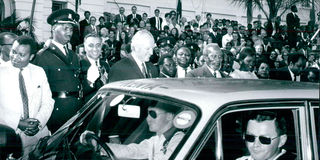Tie-breaker that decided the 1965 Coronation Safari Rally

President Jomo Kenyatta accompanied by Safari Rally Chairman Eric Cecil and other dignitaries at the flagging off of the 1968 Safari Rally outside City Hall in Nairobi.
What you need to know:
- He then made an appeal to the Royal Automobile Club (RAC) in England, governing body of motor sport in East Africa, seeking permission to allow advertising on competing vehicles, a request which was finally given in 1953.
- Sponsorship remains the backbone of the Safari with the KCB Bank sponsoring national Champion Karan Patel, Evans Kavisi and Nikil Sachania to compete in the WRC Safari Rally to the tune of Sh17.4 million, and Sh100 million for the WRC Safari Rally as a financial partner.
Eric Cecil, a founder member of the Coronation Safari Rally, took leave of absence in 1956 from the organising team to attempt the Coronation Safari Rally, and to get a feel of the monster he had created three years earlier whose reputation was fast attracting the attention of the motoring fraternity in Europe.
Cecil and Tony Vickers drove well and employed their wealth of experience of more than 10 years to win the race in a most dramatic way at the Langa Langa Racing Circuit in Nakuru, where the winner of the Coronation Safari Rally was decided in a tie-breaker after a 4,290-kilometre marathon through the three East Africa countries after it emerged that 13 drivers had arrived at the finish with the same number of penalty points.
The finishers were later to drive to Nairobi in a convoy for the ceremonial finish.The Coronation Safari Rally also attracted the first top European professional that year.
Maurice Gatsonides, the 1953 Monte Carlo Rally winner, and eighth in 1956 visited Kenya to try his luck, having been inspired by the reputation of the Coronation Safari Rally as an exciting adventure in the wild, fast spreading in Europe like a bush fire.
Gatsonides enlisted the services of the local Standard Triumph franchise manager Vic Gossington in a Standard Vanguard as a navigator who guided him remarkably well throughout the rally where thousands of people lined up along the route.
Hundreds of thousands of fans either walked to the nearest Christian missions outposts to follow live updates on radio.
Gatsonides was among the early pace setters, and would have actually won the race had Gossington not clocked early at a control, and they were later penalised four minutes.
While he was disappointed, Gossington’s mistake inadvertently only enhanced the reputation of the Coronation Safari Rally and more interest from the rest of the world which was getting accustomed to the “tough and unpredictable” nature of the event.
Gatsonides somehow produced excellent speeds in some sections of that year’s competition, which was the driest since inception, to finish third overall. The Coronation Safari Rally also produced the highest number of finishers at Nakuru, with 13 tied on points. Having reached this far level was an achievement.
Organisers had to apply a unique tie-breaker rule to decide the winner. Every driver was given a single lap drive around Langa Langa, pretty much like in today’s qualifying rounds in Formula One, to determine the winner. However, the fastest time was decided through a complex mathematical formula.
The single round test time recorded was multiplied by a coefficient based on the cylinder capacity of the car. This calculation plus the tight and twisty nature of the circuit gave an advantage to the smaller cars. But Jim Heather Hayes and his wife Mary Hayes clocked the fastest time in the stronger Mercedes Benz-220A.
Cecil and Tony Vickers were the second fastest in the smaller DKW which had less scratches on the bodywork. Note that from the early days points were deducted at scrutineering on visible damaged or missing shell body parts.
A similar classical example was to be recorded in the 1973 East African Safari Rally 17 years later when the winner was decided in a similar tie-breaker rule of “Cleanest, Furthest,” or simply put victory given to the car that had gone furthest without penalties and with minimal body shell damages.
This was after Harry Kallstrom of Sweden grabbed the lead with 70km to go when the rally leader, Hannu Mikkola of Finland (Ford Escort) hit a bank and suffered irreparable damage. Kallstrom lost it to Shekhar Mehta after getting bogged down in mud
Mehta’s 240Z was faster and arrived one minute ahead of Kallstrom in a Datsun 1800SS. But he incurred a minute’s penalty at scrutineering for a missing side light. Booth were now level at 406 points.
The tie-breaker was decided on the “furthest, cleanest rule’ or simply put the car which had gone furthest without incurring a penalty was the winner.
Cecil also won another important battle from the East Africa Automobile Association (EAAA) who grudgingly allowed competing drivers to raise money through advertising from commercial sponsors.
It should be remembered that EAAA had denied Cecil any form of financing a private sporting event. So in 1953, he went out to market and sought the finances from the East African Standard, Shell Oil Company and East African Airways.
He then made an appeal to the Royal Automobile Club (RAC) in England, governing body of motor sport in East Africa, seeking permission to allow advertising on competing vehicles, a request which was finally given in 1953.
Sponsorship remains the backbone of the Safari with the KCB Bank sponsoring national Champion Karan Patel, Evans Kavisi and Nikil Sachania to compete in the WRC Safari Rally to the tune of Sh17.4 million, and Sh100 million for the WRC Safari Rally as a financial partner.




